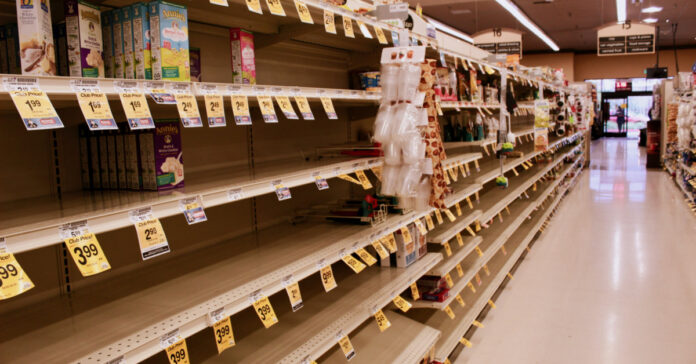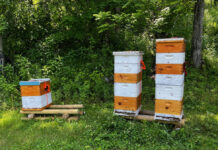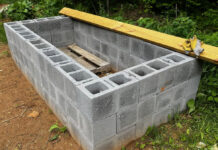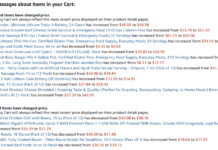I recommend you go to this article and watch the video. It’s all local shoppers talking about how empty the shelves are. No pundits or talking heads, no corporate spokespeople making excuses, just pictures of barren grocery store shelves and customers complaining about how there is no food to be found in the area. One man predicts people will starve and says, “It’s gonna get rough around here.”
It’s not just meat and fresh vegetables, but dairy products, eggs, bread, and even lunch meat and frozen foods. If you want to see more images, just look for the hash tag #emptyshelvesbiden.
The problem seems to be largely in areas where omicron is bad, with the situation in some areas exacerbated by bad weather. Still, if grocery stores in your area are empty, it doesn’t matter if the shelves are full somewhere else. People aren’t going to drive to Florida to buy groceries.
How to Prep for no Fresh Food
Unless you already have a garden, there’s a limit to what you can do to get instant fresh vegetables. I would recommend sprouting and growing microgreens.
Depending on the seeds you use, you can eat sprouts in three or four days. Microgreens take longer, say a week to ten days. People often think these are the same thing, but there are two big differences: With sprouts, you are eating the sprout of the plant shortly after it germinates, an they are grown with no soil. With microgreens, the seeds are planted in dirt and you delay harvest to allow them to shoot up a few inches and develop leaves. These leaves are what put the green in microgreens. With sprouts, you eat the entire thing, but with microgreens you harvest the tops.
Both are pretty easy to grow and can be done on a small scale in your home. Many people grow sprouts in jars in their kitchen. Microgreens require more equipment, including grow lights. We bought most of our supplies online, including pounds of seeds. Note that grow lights are now available in LEDs instead of fluorescent and as a result use less power. That gives you the option of using a solar generator to power the lights during a SHTF situation.
Here’s a quick video on how to grow your own microgreens:
We like to use our microgreens in omelets made with just-harvested fresh eggs, but they are also excellent on sandwiches. You can use them in salads, of course, but don’t expect them to entirely replace lettuce as they are far more delicate.
Replacing Dairy Products
Milking cows or goats is a serious commitment and I would guess that more homesteaders don’t raise dairy animals than do. If you do, that creates an opportunity to make a wide variety of dairy products, like soft cheeses, hard cheeses, butter, and cream, in addition to milk. If you don’t have any dairy animals, see if any of your neighbors do. When the goats first freshen, they may give so much milk their owners will happily trade.
Otherwise, your option is to store powdered milk or cans of condensed milk. I understand you can make cheese from reconstituted powdered milk, but I have never tried. Regardless of what kind of milk you use to make cheese, you will need some basic equipment and some rennet, which is what helps create the curds.
Replacing fresh Meat
Unless you raise livestock, your best bet for what to eat during a shortage is going to be meat already stored in your freezer. Hopefully, you have enough to last you a few weeks or more. Then there is canned meat, followed by freeze dried meat or meat in pouches like MREs.
Is canned meat going to be as good as a steak? Nope, but freeze dried might be, especially if you have a machine and freeze dry it yourself. Meat in pouches is similar to canned meat, but at a higher price.
Alternatives to the Grocery Store
If your grocery stores have empty shelves, there are places you may still find fresh vegetables, dairy or meat products.
Club stores like Sam’s Club, Costco and BJs. Because they charge a membership fee, only a portion of the public shop here,which limits demand. Some are vertically integrated. Costco, for example, raises and slaughters their own chickens.
Local sellers. This could include a farmer’s market or even a vendor you know from the farmer’s market. Although January is a terrible time to buy locally grown vegetables, some suppliers may have greenhouses. It is an excellent time to join a CSA, which will assure you of fresh vegetables for the entire growing season. If you are afraid you will end up with too many vegetables, split your take with a friend or neighbor.
Besides fruits and vegetables, we’ve purchased goat, lamb, mutton, mushrooms (grown in a guy’s basement), goat’s cheese, mead, and baked goods at our local farmer’s market. Good ones carry so much more that what’s in the garden that week.
Local sellers may also include ethnic butchers and other specialty stores. For example, when I lived in New York, I occasionally ate at a deli that made its own corned beef in the basement. These folks have a different supply chain than high-volume grocers.
There are plenty of beef growers who will sell you half or a quarter of a cow, and others that will sell you pork or goat. You may need to pre-order, although some farms sell by the cut. In our last home, we would drive about 40 minutes to a farmer that was open every Friday and Saturday. They had an 18-foot x 12-foot garage. Inside, the walls were lined with freezer chests. You told them what you wanted, and they’d walk over to the freeze and pull it out. You could get everything from prime rib to soup bones.
As a last resort, you can order online. I’m not talking about placing an online order from Walmart or your local grocery store. I’m talking about food companies that will ship you fresh vegetables, fruit, and meats overnight. The big downside is the expensive. It comes down to how desperate are you, and how much money do you have.
Alternatively, you can order canned foods and other non-perishable pantry items from online sellers and they will arrive at your door in a few days. If you worry about shortages and have not stocked your prepper pantry, this can be an option. Check out our most recent price comparison between Amazon.com, Walmart.com, Costco.com and Samsclub.com. The results might surprise you.
Prep
I’ve lost count; is this the second or third wave of empty shelves in the past two years? Either way, it’s becoming more common. If you haven’t started prepping, what are you waiting for?







